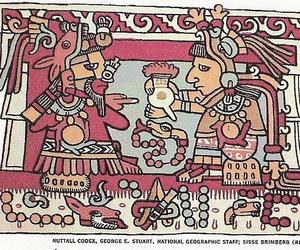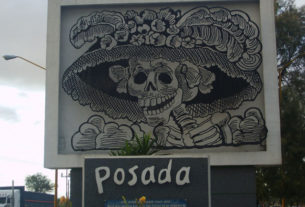Mexican History
The Conquest of Mexico by the Spaniards under Cortes in the sixteenth century brought to an abrupt end the developing civilization of the ancient Aztecs. With the destruction of their capital of Tenochtitlan (now modern Mexico City) much of Aztec religion and culture was destroyed in a catastrophic cultural holocaust.
However, within a few decades of the Conquest, Franciscan friars — notably Bernardino de Sahagun — had established a school for survivors or their offspring at Tlatelolco, not far from present day Mexico City.

Prior to the Conquest, the Aztecs had developed a highly efficient means of written or painted communication through a combination of signs or symbols: phonetic (representing the actual forms of Nahuatl, the speech of the Aztecs), ideographic (indicating ideas), and pictographic (illustrating actual objects). Through these means, Aztec scribes and priests were able to record historical and religious records in codices, long strips of amatl (native paper) in the form of screenfolds, which could be opened and closed much in the manner of the modern book format.
Very few of these codices survived the Spanish Conquest. However, we have sufficient evidence to show that the “painted picture books” of ancient Mexico were a highly efficient means of communication, backed up by a strong oral tradition.
Thanks to this indigenous semi-literary background, native students at Tlatelolco quickly adopted the Roman transcription or alphabetic form of writing and became proficient in Spanish, Latin, and, of course, in their native Nahuatl. But were the pre-Hispanic codices and the oral tradition sufficient in themselves to preserve the “literature” of Aztec civilization in anything like its original form?
This question has vexed many researchers involved in studying and interpreting the languages and cultures of ancient Mexico, sometimes resulting in sharp differences of opinion — bordering on open academic warfare.
Much of the attention is focused on a number of poems in Nahuatl contained in several collections dating from around the middle of the sixteenth century: Cantares Mexicanos (Mexico City), Romances de los Señores de la Nueva España (University of Texas), and a collection located in Paris.
The essential question involves the authenticity of these Nahuatl poems. The participants in the discussion are roughly divided into two main camps: those who believe that the poems were composed by Aztec poets who lived before the time of the Conquest, and those who are equally convinced that the poems were written after the Conquest although they “borrowed” traditional elements from the pre-Conquest culture. The question is not a trivial one because the answer very much affects our current understanding and interpretation of Aztec culture and history.
The standard view is that of the late A. Garibay and his prime student M. Leon-Portilla, who regard the poems as essentially pre-Conquest compositions by historical rulers of ancient Mexico. The main theme of the poems is summed up in the Nahuatl phrase in xochitl in cuicatl (flower and song), which these two Mexican scholars interpret as a reference to the cultivation of the art of poetry and evidence for a sophisticated level of philosophical speculation among the intellectual elite.
Opposed to this interpretation are scholars such as G. Payas, A. Segal, and J. Bierhorst, to name only a few. Payas maintains that Garibay forced the Nahuatl texts into a classical format to amplify their credibility and then interpreted them to fit his preconceived notion of Aztec society. Segala argues that in such a highly ritualized society as that of the Aztecs there was no notion of individualism, and yet the Nahuatl poems appear to be highly individualistic. Therefore, so the argument goes, this invalidates the theory of Garibay and Leon-Portilla about the existence of pre-Conquest poet-kings. But Bierhorst goes the furthest of all with his “Ghost Warrior” theory.
Bierhorst begins with the basic assumption that all the Nahuatl poems were composed and written down after the Conquest. In this view, the phrase in xochitl in cuicatl does not refer to poetry but to songs designed to summon the spirits of dead warriors to earth to help the vanquished Aztecs. The “flowers” (xochitl) refer to these warriors who appear as ghosts descending from heaven fully armed and ready to fight in payment for which they demand human sacrifice.
Christian references do appear in the poems but Bierhorst sees Christian influence throughout, the ghosts sometimes appearing as angels or rosary beads. Bierhorst, like other opponents of the Garibay-Leon-Portilla interpretation, charges that these two scholars made too many unwarranted changes in the texts, over-emphasized their antiquity, left out Spanish loan words and Christian references, and — worst of all — almost deliberately mistranslated in order to give the Nahuatl poems a greater aura of authenticity.
There are valid arguments pro and con on both sides of this controversy regarding the correct interpretation of the Nahuatl poems contained in the three collections mentioned above.
The consequences are not insignificant, for if the poems were in fact written after the Conquest under the auspices of the Franciscan friars, then we would have to abandon the idea that the poems were composed by historical poet-kings of ancient Mexico and the “Flower-Song = Poetry” theory of Aztec society would fall apart.
If, on the other hand, the Nahuatl poems were in fact composed by the poet-kings whose names appear in the poems, we are then faced with the formidable task of explaining, for example, how a poem purportedly “written” by Tlaltecatzin — a lord of Cuauhchinanco (in the present state of Puebla), in the middle of the 14th century — managed to survive several hundred years down to the middle of the 16th century before writing was introduced by the Franciscans, when it happened to find its way into the written text which we have today (see for example, Leon-Portilla, Trece Poetas del Mundo Azteca, pages 27-37). Moreover, the original text of the Cantares Mexicanos in which this poem is found is a rough paleographical manuscript which had to be interpreted before it could even be written out in a readable form of Classical Nahuatl.
Clearly we have some serious problems here.
Some recent commentators on Tlaltecatzin and others simply assume that we have the very words of these pre-Conquest poet-kings without bothering to explain how these written texts came into existence before the advent of writing among the Aztecs under colonial rule.
An Internet article that appears to be a chapter from a book in progress, entitled somewhat grandly “The Epistemological worth of the Maya concept of Kinh and the Nahuatl concept of Xochitl,” illustrates this problem.
The unnamed author presents a highly sophisticated philosophical dissertation on the profound meanings supposedly running through the head of Tlaltecatzin, this 14th century Texcocan ruler. For example, in explaining the reference to the mixed flowery chocolate drink (xochincacahuatl) and pulque curado (xochioctli) mentioned in the poem, our author comments “He [Tlaltecatzin] is also obviously expressing his erotic desires for his mate….”
Well, maybe, maybe not. Only Tlaltecatzin knows that, and he is long since dead. Moreover, this author’s observations on Tlaltecatzin’s state of mind in the 14th century is based on an English translation of the variant version of this poem found not in the Cantares, but in the Romances. Moreover, Garibay (Poesia Nahuatl III, Mexico 1958, page XXX) appears to throw some doubt even on the authorship of the poem as found in the Romances.
Garibay writes: Cabe una posibilidad más. No es un personaje humano, sino una divinidad que era celebrada en aquella región (There is another possibility. It is not a human character but a divinity that was venerated in that area).
However, in Leon-Portilla’s version and translation of this same poem (with variations), he leaves no doubt that he believes the historical ruler Tlaltecatzin is the author of the Nahuatl poem. Here Leon-Portilla seems to be at some variance with his mentor Garibay.
What are we to make of all this?
First, there is obviously a lot of false or misleading information going the rounds, especially on the Internet where there is no peer review and articles are usually unsigned and lacking references. Writers on the subject of the Nahuatl poems often base their commentaries on sometimes dubious translations, or rather broad interpretations or even mere guesses at what the texts really mean. We owe a great debt of gratitude to scholars such as A. Garibay and Leon-Portilla for their all-important preliminary groundwork, but much more work remains to be done.
The great difficulty in dealing with these esoteric but highly important sources of information on Aztec society is due partly to the radically different interpretations that can be placed upon the same texts. Besides, we lack manuscript evidence for the poem of Tlaltecatzin prior to the time it was written down after the Conquest of Mexico.
Do we or do we not have an authentic pre-Hispanic poem that has somehow survived from the 14th century to the present day? Was Tlaltecatzin a historical personage, some kind of deity, a “Ghost Warrior,” or a poet?
We shall attempt to provide answers in future articles.

